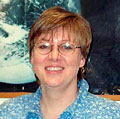 |
|
|
| Author |
Message |
Patty_Cie

Joined: 23 Mar 2004
Posts: 87

|
 Posted:
Sat Jun 19, 2004 9:56 pm Posted:
Sat Jun 19, 2004 9:56 pm |
  |
June 13, 2004 Sunday
10:00 PM Alaska time
As phytoplankton dies, it decays and sinks. Uneaten pieces of animal carcasses also decay and sink. Some of the sinking mass reaches the ocean floor and is added to the benthic layer of marine ooze, also known as mud.
In the SBI study area, mud has some interesting properties. To begin with, it is about 80% water. There are two distinct top layers with the not-so-scientific names of fluff and slop where the oxidation and reduction of metals occur. Fluff and slop range in depth from a few millimeters to a few centimeters. The fluff layer is brown and looks like chocolate mousse. It has a lot of available oxygen for benthic organisms. The next layer is called slop. The slop is stiffer than the fluff and looks like day-old chocolate pudding. It contains a lot of manganese. After the slop, the mud turns black and becomes anaerobic (depleted of oxygen).
It is the denitrifying bacteria living within the anaerobic mud that University of Washington’s School of Oceanography research professor, Al Devol and PhD student, Bonnie Chang, are on the Healy to study. The question they are addressing through their research is, “What is the rate and amount of denitrification and how important is it to the global marine nitrogen balance?”
Denitrification is the conversion of nitrate to nitrogen gas in anaerobic conditions. Approximately one half of the world’s denitrification occurs in three locations: the eastern tropical North Pacific, eastern tropical South Pacific and the Arabian Sea. The other half happens in the shallow ocean sediments of the continental margins (continental shelf plus the continental slope). Because the Arctic Ocean contains 25% of the world’s continental margins, it makes an excellent study area for Al and Bonnie.
To obtain their samples, Al and Bonnie use a multi-corer. The multi-corer is connected to a winch wire and set over the stern of the ship. When is reaches the seafloor, it triggers and collects eight 50 centimeter (cm) cores without disturbing the stratification of the sediment column.

The multi-corer collects eight samples at a time.
Three cores are used for chemical depth profiling. One core is measured for changes (flux) in nitrogen. Another core is measured for oxygen and the last core is measured for sulfate. Each core is sectioned into 5 mm and 1 cm slices. The slices are measured for their individual chemical flux. For example, if the nitrate decreases, then Al and Bonnie have an indication that more denitrifying bacteria are present and removing nitrate.

Bonnie slices three cores for chemical depth profiles.
Two of the cores are sub-cored for metabolism measurements. The top 20 cm are carefully removed from the sediment column and taken to a cold room. Beginning nitrogen and oxygen gas measurements are taken using a Quadrapole Mass Spectrometer. The sub-cores are incubated for 24 to 48 hours. During the incubation period, they are constantly stirred using a magnetic stirrer turning at one revolution per second. At the end of the incubation period, the nitrogen and oxygen levels are measured again. If the nitrogen levels increased, then denitrification occurred. Mathematically Al and Bonnie can determine the rate of denitrification from the amount of nitrogen gas produced divided by the area of sediment divided by the length of the incubation period (gas/cm2/time).

Al carefully carries the 20 cm sub-core to the cold room for metabolic experiments.
The last three cores are for backup. They can be used in replicate experiments, donated to other scientists or not used. Typically, a core is not used only if something is wrong with the core. For instance, sometimes a core inadvertently collects an animal. Animal respiration would skew Al and Bonnie’s data making them unusable for their experiments.

Sometimes animals are collected in the core. This core is not usable for Al and Bonnie’s experiments. Picture by Bonnie Chang.
To see photographs taken by Steve Roberts of UCAR/JOSS, click here. |
|
|
    |
 |
|
|
|
View next topic
View previous topic
You cannot post new topics in this forum
You cannot reply to topics in this forum
You cannot edit your posts in this forum
You cannot delete your posts in this forum
You cannot vote in polls in this forum
You cannot attach files in this forum
You can download files in this forum
|
Powered by phpBB 2.0.11
© 2001, 2002 phpBB Group :: FI Theme ::
All times are GMT
| |
